SEO
A 4-Step Guide To Improving SEO With Powerful Topic Clusters

This post was sponsored by iQuanti. The opinions expressed in this article are the sponsor’s own.
What transforms a website from just a catalog of blog posts to a highly-organized hub of authoritative content?
How can you make sure your website becomes the top-visited resource for your industry?
Today, we’re going to travel down the content rabbit hole, and peer through the SEO looking glass, if you will.
You’ll discover how to easily merge content creation and SEO to help your website successfully rank at the top of search engine results pages (SERPs) using topic clusters.
Your goal: Create content that is able to answer your target audience’s questions by providing everything they need to know about their search queries.
The classic Alice in Wonderland series posed a quasi-metaphorical question to its protagonist: “Why is a raven like a writing desk?”
The question posited has nothing to do with the plot, leaves nothing to inform the characters’ growth or intentions, and may very well be construed as pure nonsense, a symptom of fantasy.
At the end of the story, Alice asks The Hatter, “Why is a raven like a writing desk?”
Though no answer was provided – and many answers have been theorized since – readers not only embrace this fantastical reality but champion it as part of the inherent logic of the narrative.
We’ve come to Wonderland to believe in the absurd possibilities of this reality, however nonsensical they may appear.
When it comes to your SEO strategy, you won’t be delving into fictional worlds or constructing outlandish characters and situations. You will, however, be in command of your narrative and its inherent logic.
You will need to:
- Understand what your audience is looking for or trying to understand, lest you lose out on active users’ time on your page – a critical metric in search engine algorithms.
- Know how your content is interconnected, how to prioritize it, and how to measure its impact.
- Remember why it’s essential to keep your customer following the narrative down the content rabbit hole.
Step 1: Understand & Track Search Intent
Your audience’s search history and webpage behavior can speak volumes about their search intent and needs, even if it’s impossible to actually know what’s going on in a person’s mind.
SEO’s analytical aspects can uncover search intent based on keyword queries.
If you pair SEO analytics with subject-matter experts (SMEs), you can also supercharge your strategy by plotting topical interests and predicting a person’s position within your marketing funnel.
How To Discover Search Intent To Build Successful Topic Clusters
You and your SMEs can easily develop one or more themed keyword landscapes, or “topic clusters”, by simply researching the root of a regular person’s keyword queries:
- Define query intent across your customer journey. Are your customers more likely to use search terms that signal awareness, consideration, comparison, or purchase intent in different parts of your sales and marketing funnel?
- Audit your existing keyword footprint, your competitive footprint, and your pay-per-click (PPC) performance.
- Explore and document new keyword opportunities that logically arise from your audit.
- Compile a master keyword list.
Your master keyword list will help you and your team clearly understand how your points of entry can be better positioned or supported on a user’s journey through your sales funnel.
Step 2: Create A Master Keyword List To Uncover Keyword Gaps & Cluster Foundations
You’ll want to walk away from step one with a master keyword list that will help you discover the content gaps that can be used to bridge your past content efforts with your present or future ones.
This helps you quickly see if your target audience’s search intent matches your website’s page intent.
Why A Master Keyword List Works
Master keyword lists work because they help make sure you’re covering every need of your target audience.
Once you’ve completed your master keyword list, look at how complete and logical your list of targeted keywords truly is.
Ask yourself if a reader finds your website after a query:
- Will they need to take a step back to figure out how believable or valid the information you’re presenting them is?
- Will the provided backlinks on that page assume that this user knows all they need to know, while attempting to redirect them to a product page without informing them of how you perform better than your competitors?
Either of these paths can quickly become disjointed without a logical flow of information.
That’s where the last high-level takeaway from your master keyword list can be beneficial: spinning a web of core, supporting, and related themes to ensnare and enthrall your user.
This is what creates the foundation of topic clusters.
 Image created by iQuanti, January 2023
Image created by iQuanti, January 2023Step 3: Create Content & Topic Clusters
As you’ve seen, search intent needs to translate to page intent.
So, careful consideration during the keyword selection phase is key for content creation because of the many themes and subthemes that your brand, products, and services may cover.
These subthemes are the pillars of your topic cluster strategy. Implementing content clusters is an effective means of covering full topics in organized, digestible bites.
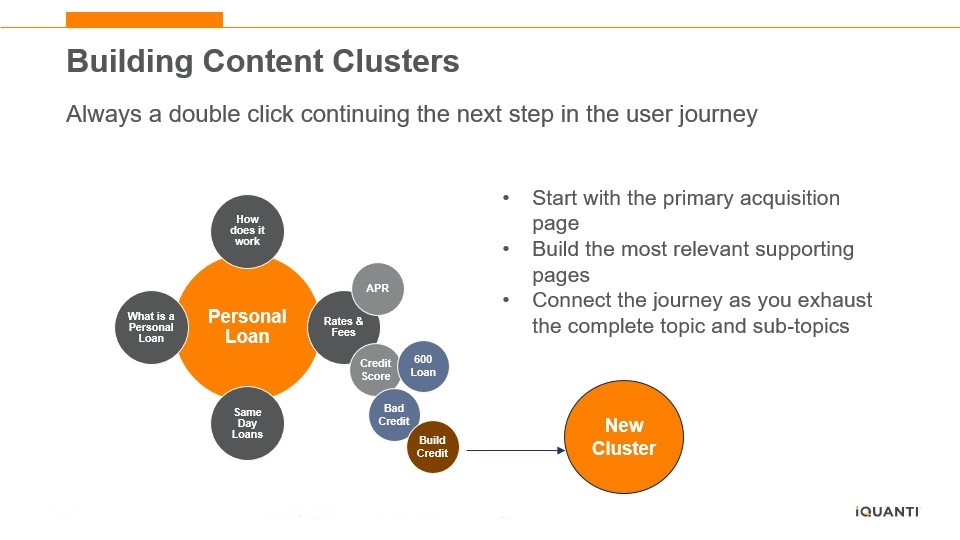 Image created by iQuanti, January 2023
Image created by iQuanti, January 2023How To Create Content Clusters
Once your audience stumbles upon your landing page, the content must be compelling enough to draw their attention further.
Engage perceptions with stats and diagrams, provide visuals and lists, condense information, and challenge inquisitive minds to learn more on the next page.
Here’s how:
- Select your highest priority acquisition – conversion – pages and exhaust the themes and subthemes relating to it by building relevant awareness and consideration articles around it.
- Identify and connect the journey to different topics and subthemes with backlinks. For example, let’s say you’re building a product page for personal loans. You will naturally need to mention loan rates and credit scores to substantiate your offering.
- Create spinoff content. For example, can this spin off into article pages for “What’s a Good Credit Score?” and “How to Qualify for Affordable Loan Rates”? You could even compile information about the loan rates you offer for each credit score tier, compare your loan rates to your competitors, provide tips for improving your credit score, and so many more themes within themes.
- Enhance your content with videos, infographics, or sound bites.
As readers spin through your website, they become familiar with your brand, style, and voice, and might even develop some level of trust from their visit – if you’ve provided the information they’re looking for.
Step 4: Review Content Marketing Metrics & Analytics
Tracking where your readers explore your site more thoroughly will only further the plot – keeping in mind general consumer demand and some KPIs.
Whether it’s the value added by a narrative or a more consistent website flow, pages can be identified for their:
- Conversion rate (CVR).
- Page views.
- Impressions.
- Time on page.
- And many other relevancy qualifiers concerning their intent.
After identifying successes, you can mimic these pages, which then can be integrated into your audience’s journey.
If metrics stagnate for some pages, they might need a refresh. Exploring different keyword landscapes and bridging cluster gaps can help improve your site’s authority and user experience (UX) overall.
In the worst-case scenario – after you’ve decided it’s no longer relevant to your site visitors or from a keyword volume standpoint – you can decommission and 301 redirect any content that no longer performs in a way that fulfills your brand’s purposes.
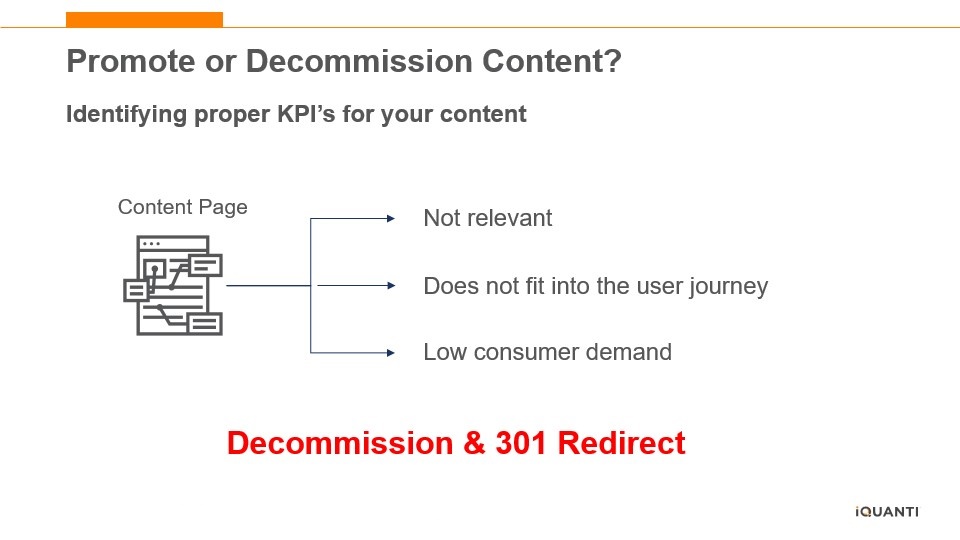 Image created by iQuanti, January 2023
Image created by iQuanti, January 2023Ensuring your site structure ranks well compared to competitors or industry aggregators can be challenging without sophisticated technological support – and there’s only so much that can be done unless you want to overhaul your website.
However, catching and nesting a customer to a purchase decision should involve an intuitive flow that won’t require the customer to encounter navigational mishaps, such as having to back out of pages.
Create A Topic Cluster-Driven World Of Your Own
At the beginning of her journey, freshly lost and before the conversation about a raven and a writing desk, Alice asks the Cheshire Cat, “Would you tell me, please, which way I ought to go from here?”
The Cat replies, “That depends a good deal on where you want to get to.”
Though we’ve all been Alice before – on a website, in a crowd, within a metaphor – you should be fostering the journey with the same absurd seriousness the Cheshire Cat proposes.
In the story, Alice must find herself before knowing what she wants to do.
Your customers may stumble upon you with questions, curiosities, and intent – are you positioning your content in a relatable way?
iQuanti uses the combination of their proprietary tech and trained UX strategists to:
- Identify and close gap deficiencies.
- Track algorithmic score changes.
- Improve site performance from a page level upwards.
If you believe you could use some help identifying content gaps or want to help drive the needle forward for your business, iQuanti’s SEO services could be just what you need.
SEO
Measuring Content Impact Across The Customer Journey
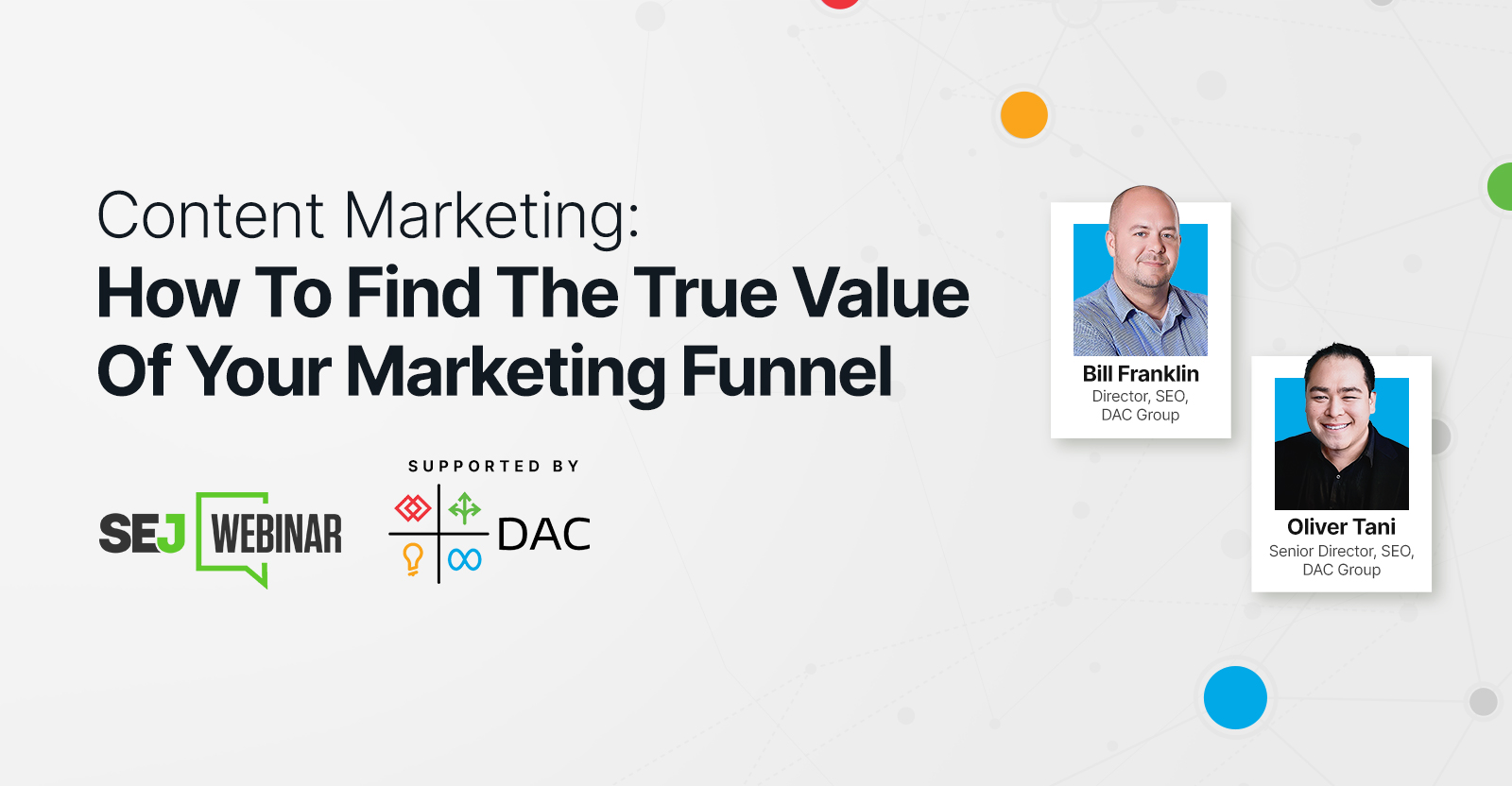
Understanding the impact of your content at every touchpoint of the customer journey is essential – but that’s easier said than done. From attracting potential leads to nurturing them into loyal customers, there are many touchpoints to look into.
So how do you identify and take advantage of these opportunities for growth?
Watch this on-demand webinar and learn a comprehensive approach for measuring the value of your content initiatives, so you can optimize resource allocation for maximum impact.
You’ll learn:
- Fresh methods for measuring your content’s impact.
- Fascinating insights using first-touch attribution, and how it differs from the usual last-touch perspective.
- Ways to persuade decision-makers to invest in more content by showcasing its value convincingly.
With Bill Franklin and Oliver Tani of DAC Group, we unravel the nuances of attribution modeling, emphasizing the significance of layering first-touch and last-touch attribution within your measurement strategy.
Check out these insights to help you craft compelling content tailored to each stage, using an approach rooted in first-hand experience to ensure your content resonates.
Whether you’re a seasoned marketer or new to content measurement, this webinar promises valuable insights and actionable tactics to elevate your SEO game and optimize your content initiatives for success.
View the slides below or check out the full webinar for all the details.
SEO
How to Find and Use Competitor Keywords
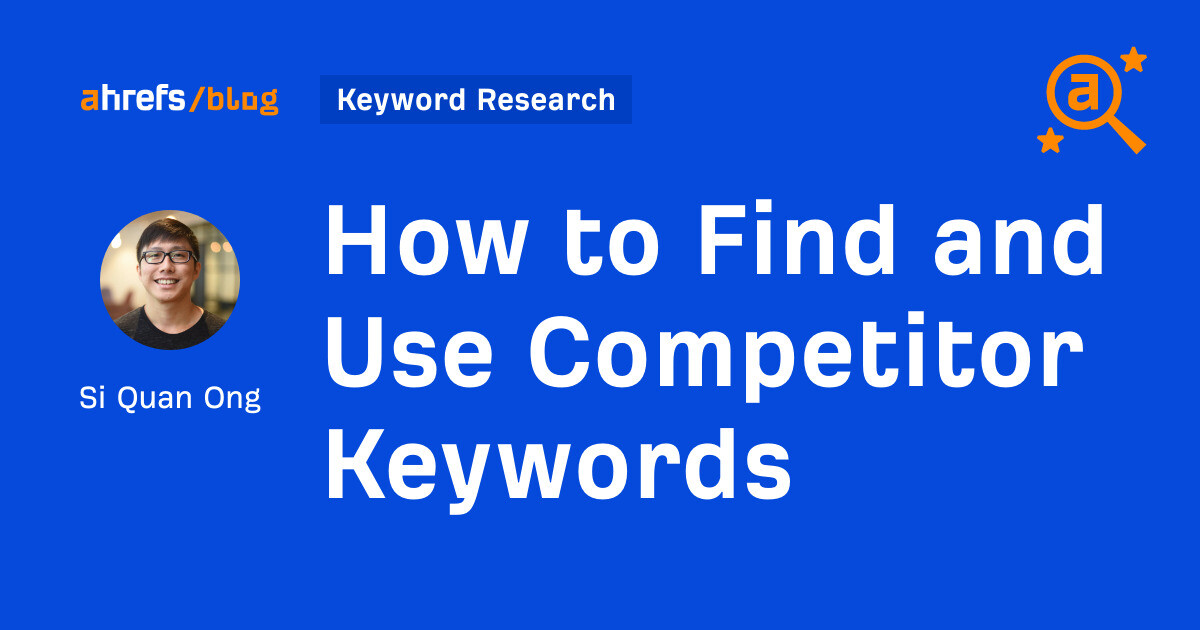
Competitor keywords are the keywords your rivals rank for in Google’s search results. They may rank organically or pay for Google Ads to rank in the paid results.
Knowing your competitors’ keywords is the easiest form of keyword research. If your competitors rank for or target particular keywords, it might be worth it for you to target them, too.
There is no way to see your competitors’ keywords without a tool like Ahrefs, which has a database of keywords and the sites that rank for them. As far as we know, Ahrefs has the biggest database of these keywords.
How to find all the keywords your competitor ranks for
- Go to Ahrefs’ Site Explorer
- Enter your competitor’s domain
- Go to the Organic keywords report
The report is sorted by traffic to show you the keywords sending your competitor the most visits. For example, Mailchimp gets most of its organic traffic from the keyword “mailchimp.”


Since you’re unlikely to rank for your competitor’s brand, you might want to exclude branded keywords from the report. You can do this by adding a Keyword > Doesn’t contain filter. In this example, we’ll filter out keywords containing “mailchimp” or any potential misspellings:
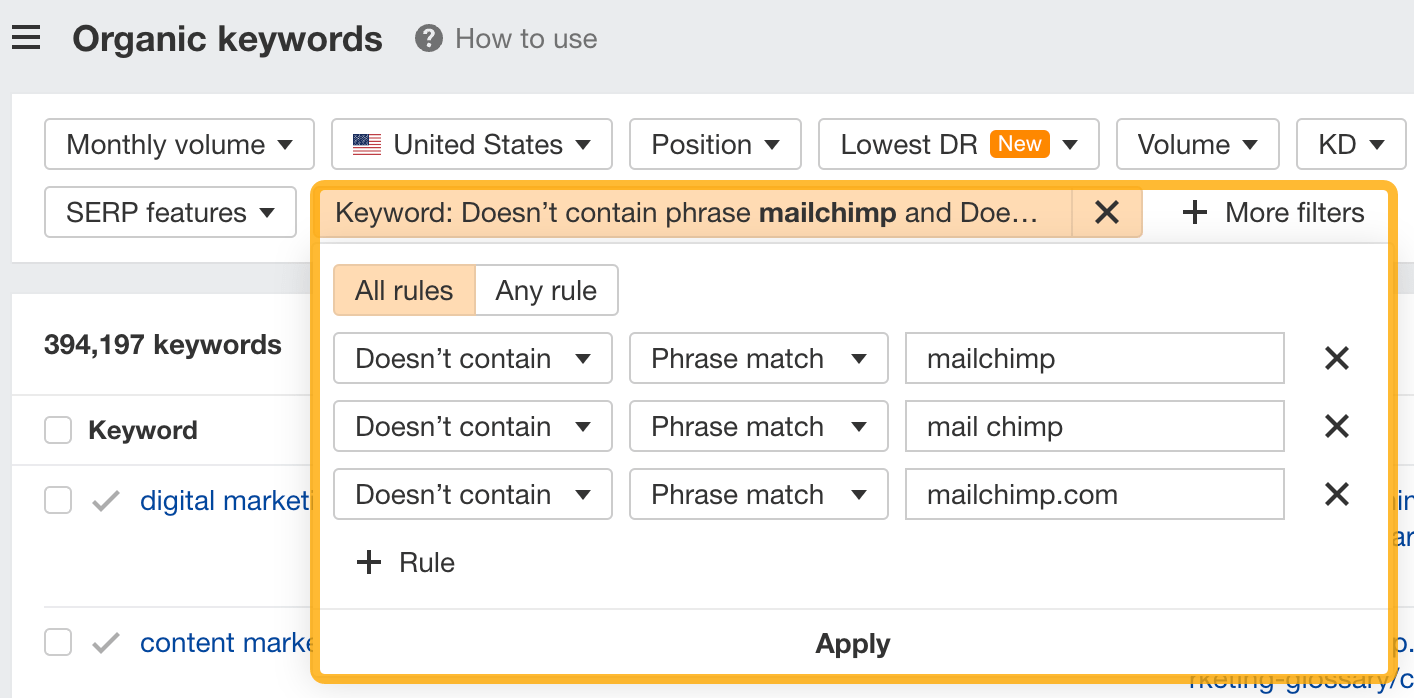

If you’re a new brand competing with one that’s established, you might also want to look for popular low-difficulty keywords. You can do this by setting the Volume filter to a minimum of 500 and the KD filter to a maximum of 10.
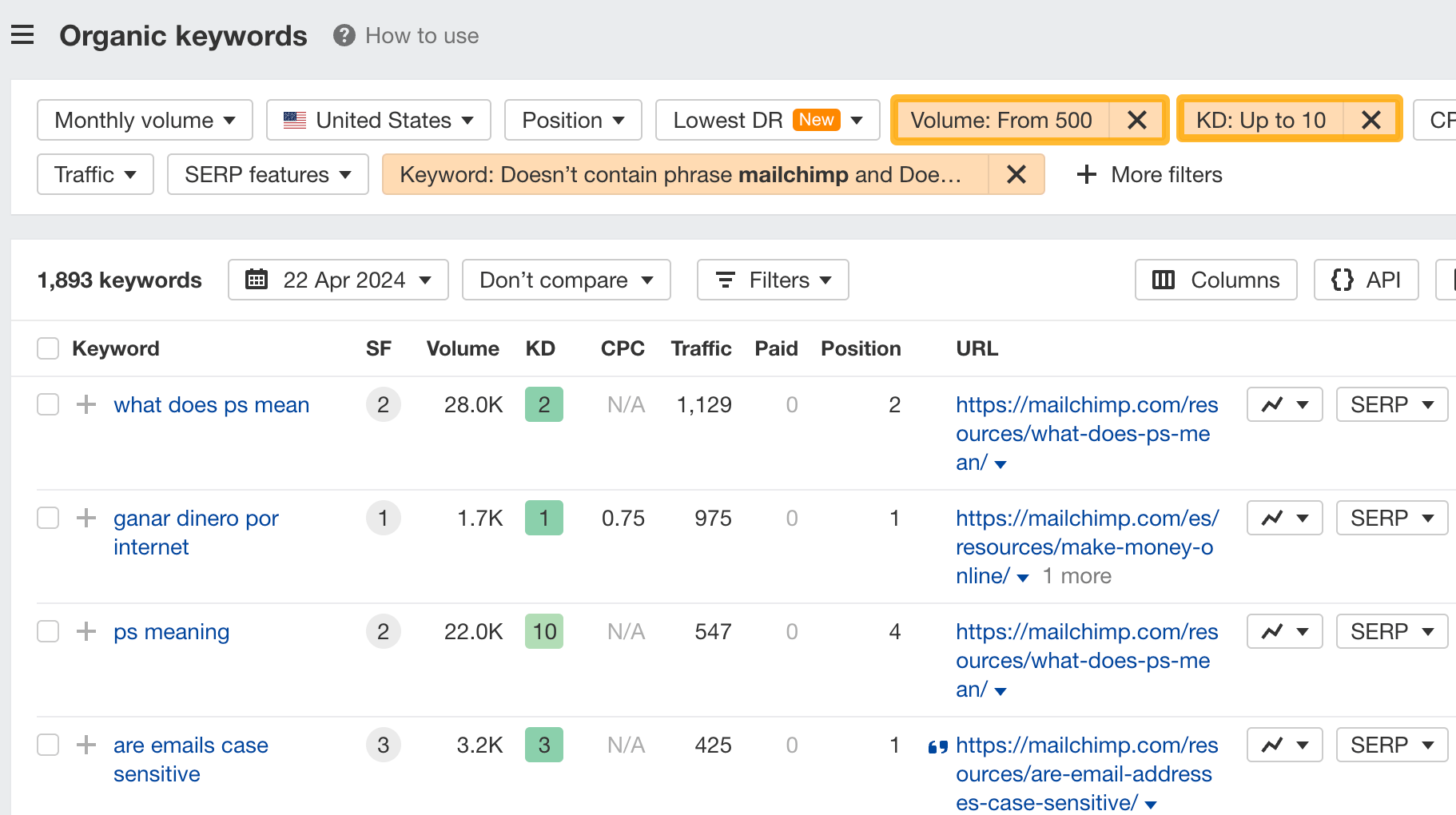

How to find keywords your competitor ranks for, but you don’t
- Go to Competitive Analysis
- Enter your domain in the This target doesn’t rank for section
- Enter your competitor’s domain in the But these competitors do section
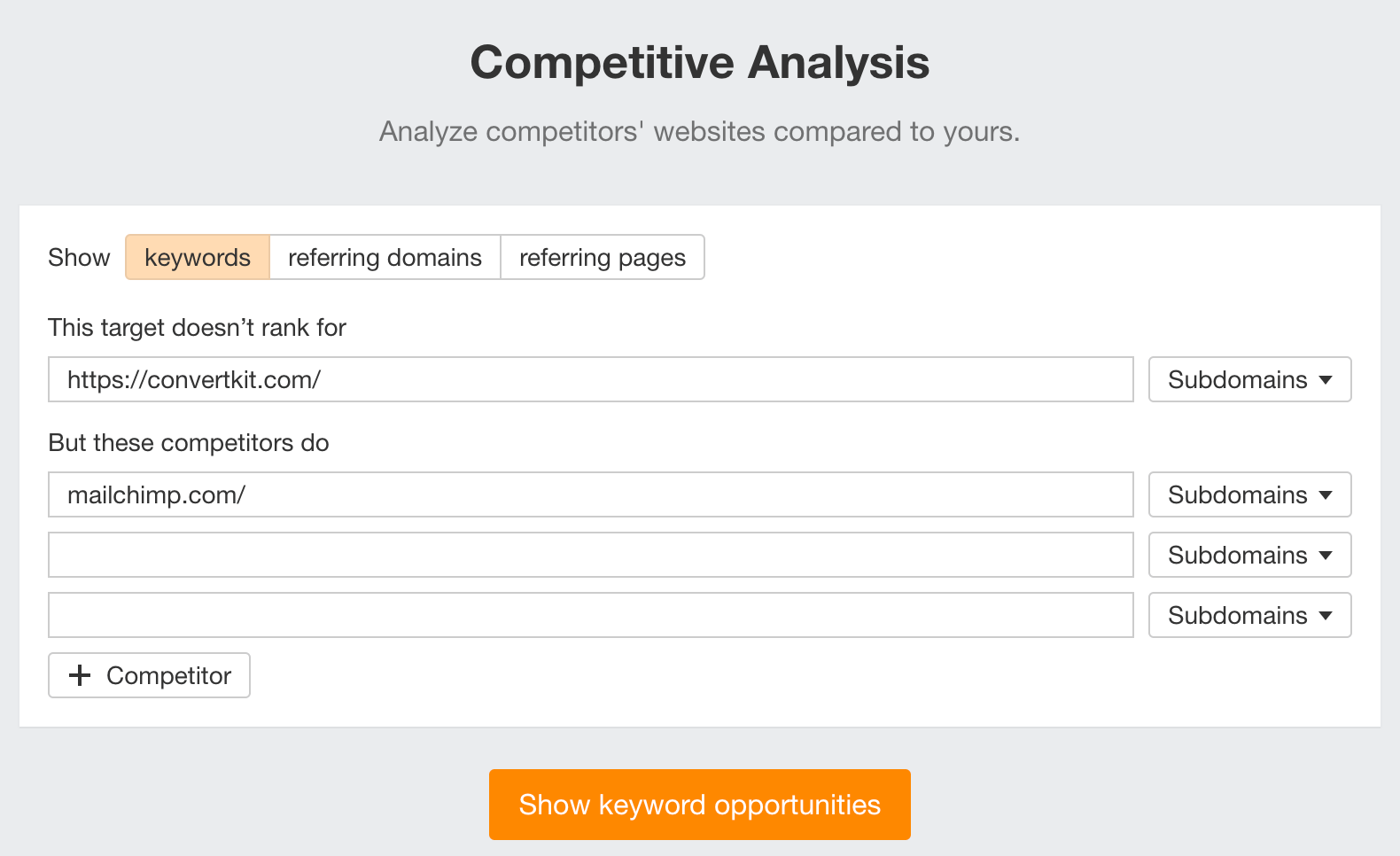

Hit “Show keyword opportunities,” and you’ll see all the keywords your competitor ranks for, but you don’t.
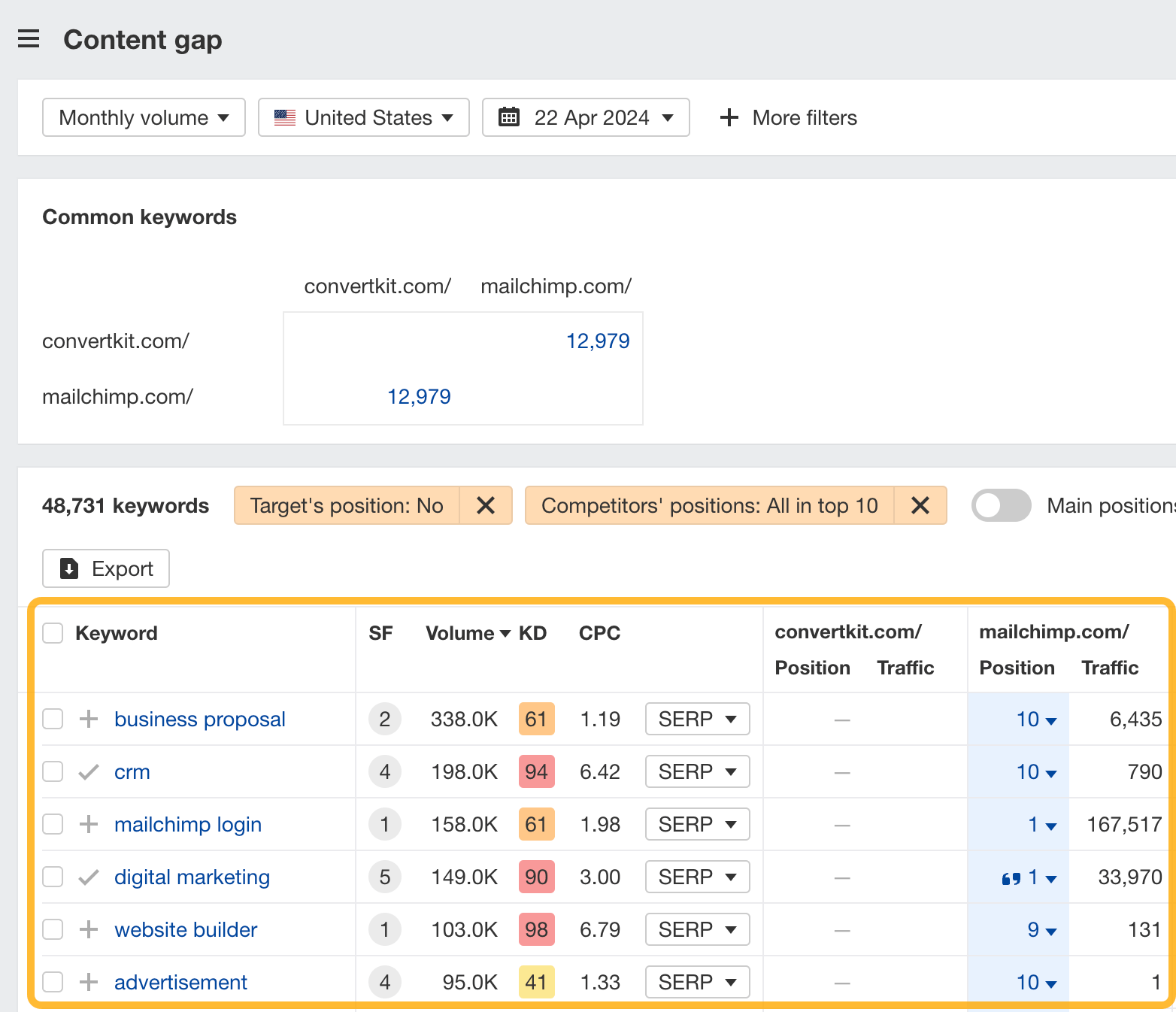

You can also add a Volume and KD filter to find popular, low-difficulty keywords in this report.
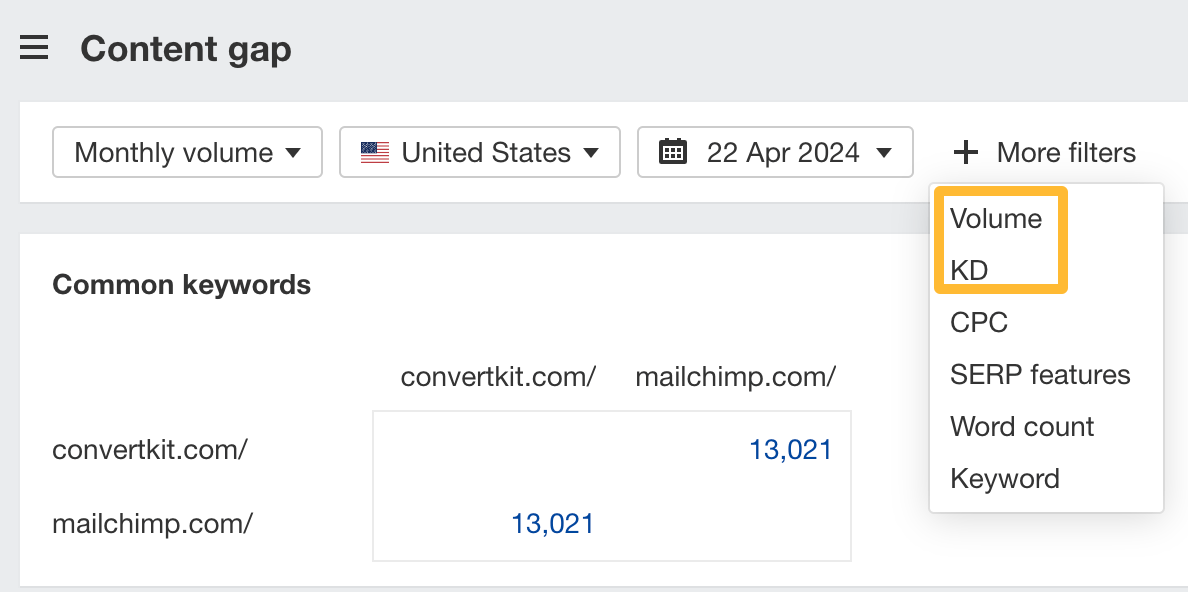

How to find keywords multiple competitors rank for, but you don’t
- Go to Competitive Analysis
- Enter your domain in the This target doesn’t rank for section
- Enter the domains of multiple competitors in the But these competitors do section
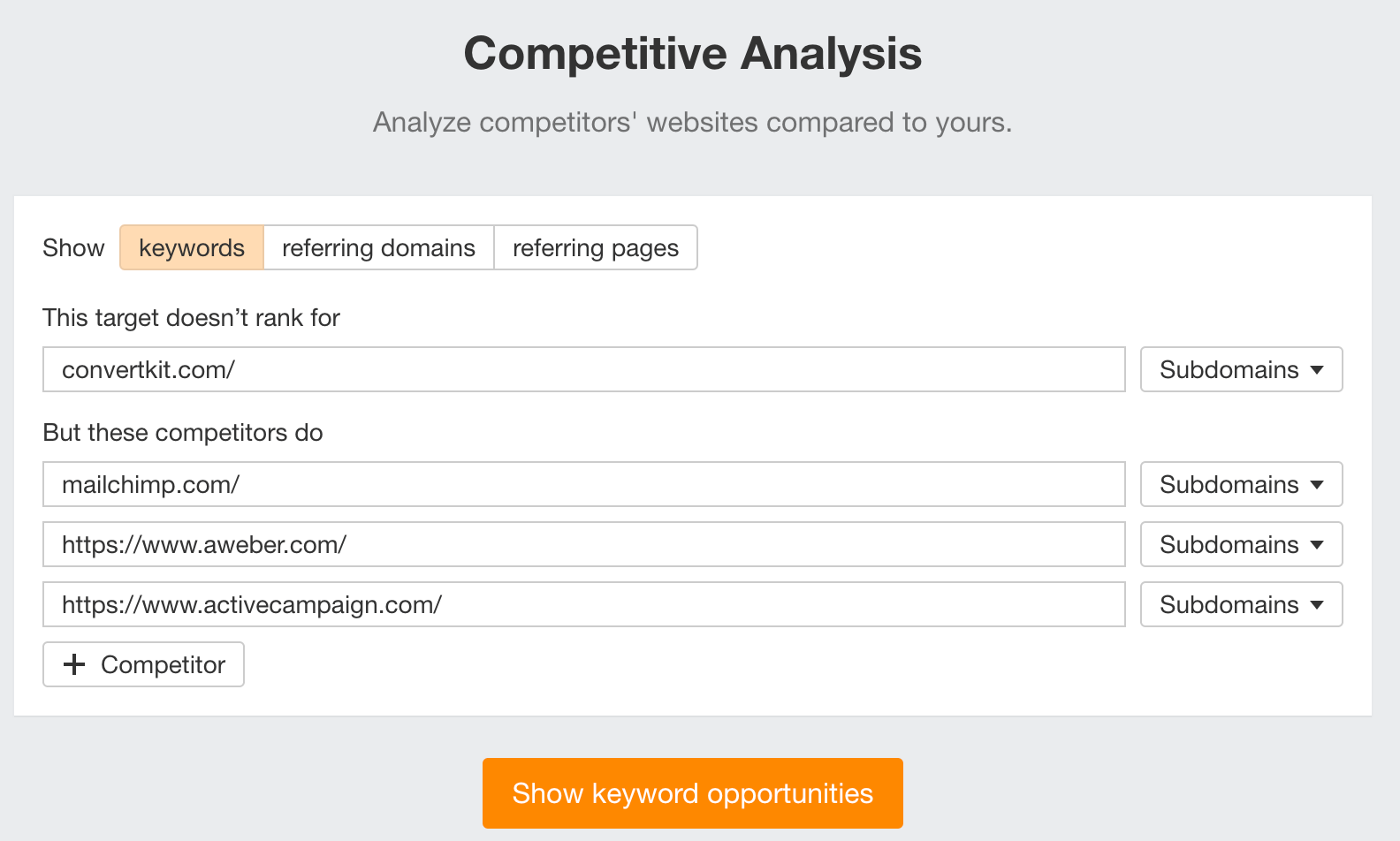

You’ll see all the keywords that at least one of these competitors ranks for, but you don’t.
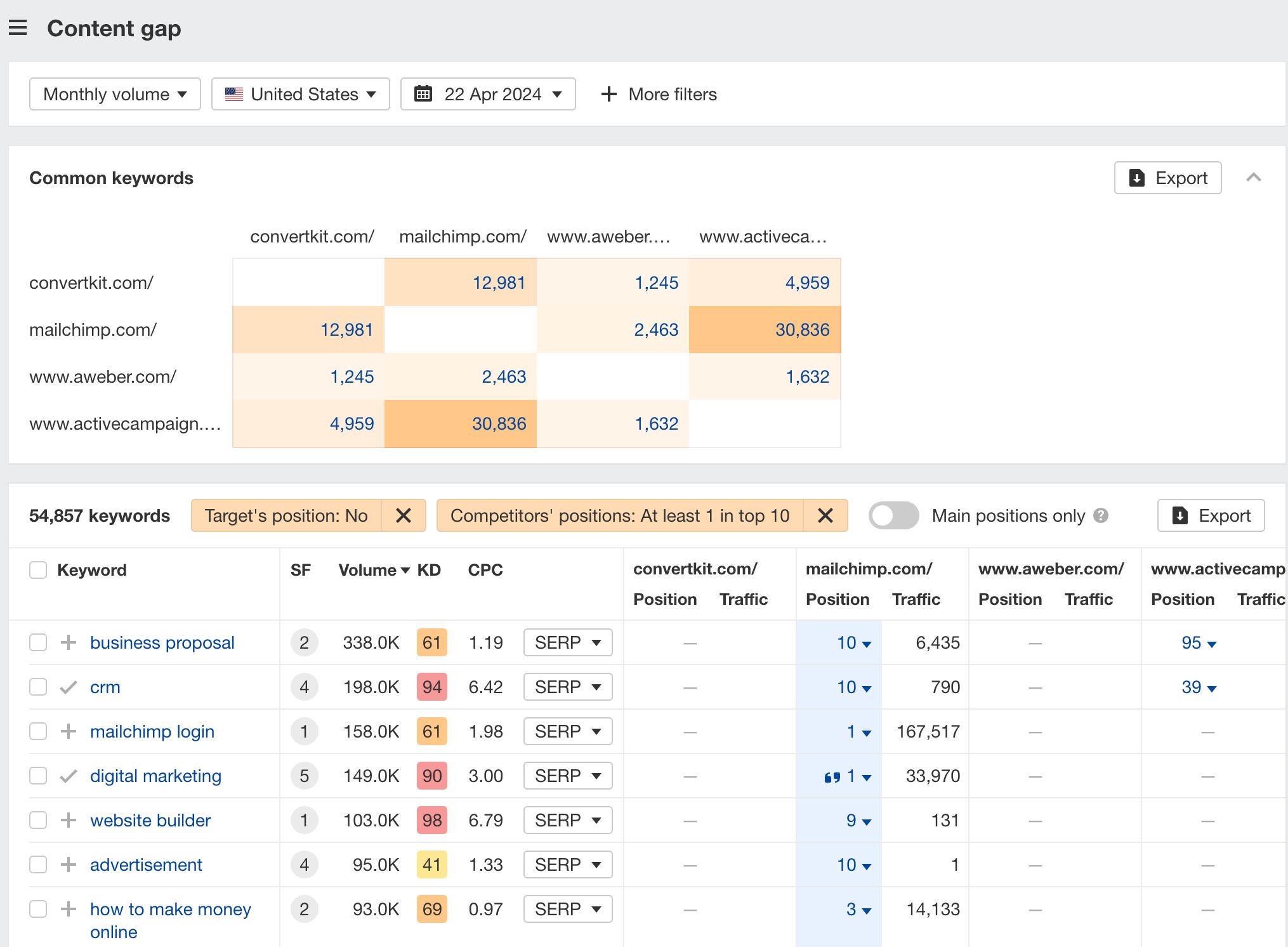

You can also narrow the list down to keywords that all competitors rank for. Click on the Competitors’ positions filter and choose All 3 competitors:
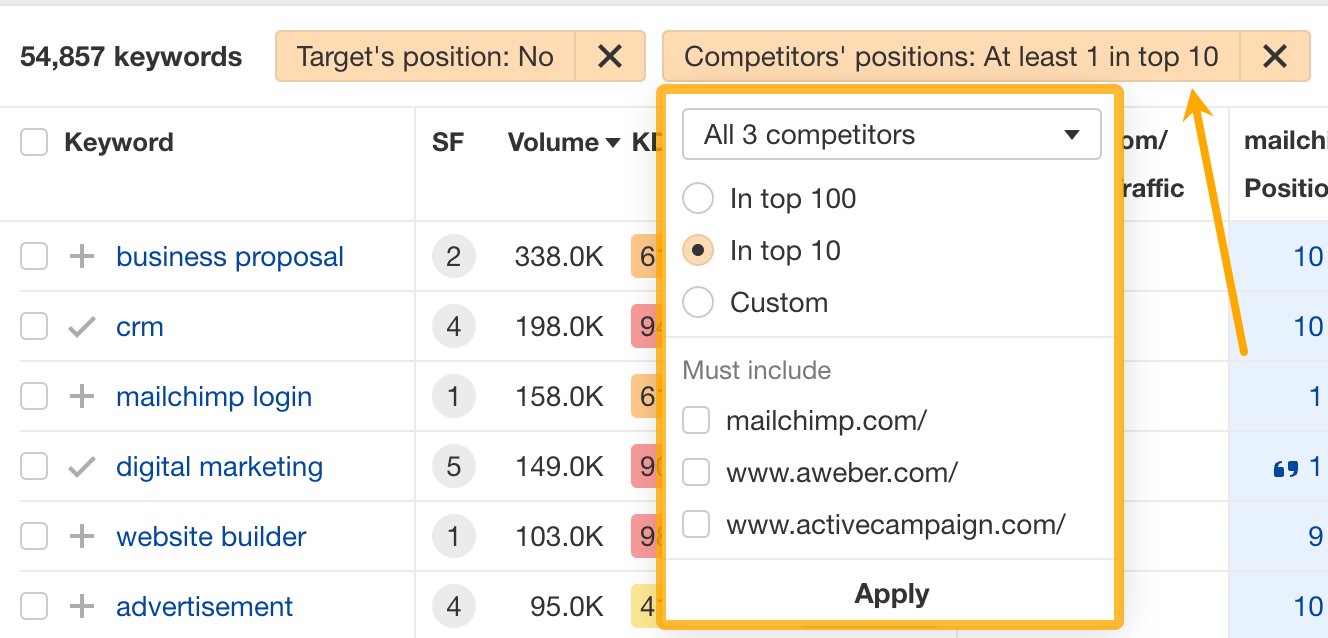

- Go to Ahrefs’ Site Explorer
- Enter your competitor’s domain
- Go to the Paid keywords report
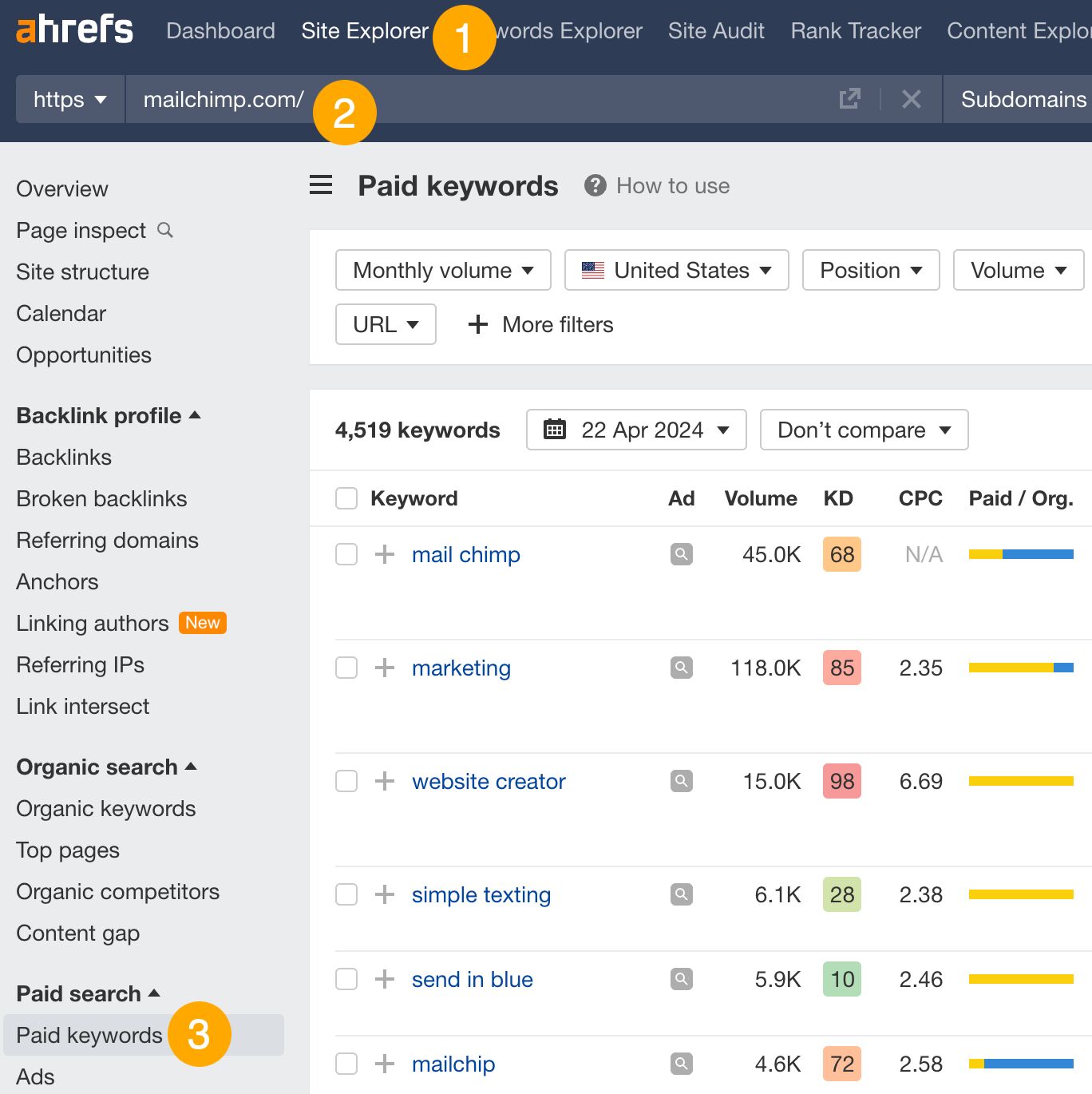

This report shows you the keywords your competitors are targeting via Google Ads.
Since your competitor is paying for traffic from these keywords, it may indicate that they’re profitable for them—and could be for you, too.
You know what keywords your competitors are ranking for or bidding on. But what do you do with them? There are basically three options.
1. Create pages to target these keywords
You can only rank for keywords if you have content about them. So, the most straightforward thing you can do for competitors’ keywords you want to rank for is to create pages to target them.
However, before you do this, it’s worth clustering your competitor’s keywords by Parent Topic. This will group keywords that mean the same or similar things so you can target them all with one page.
Here’s how to do that:
- Export your competitor’s keywords, either from the Organic Keywords or Content Gap report
- Paste them into Keywords Explorer
- Click the “Clusters by Parent Topic” tab
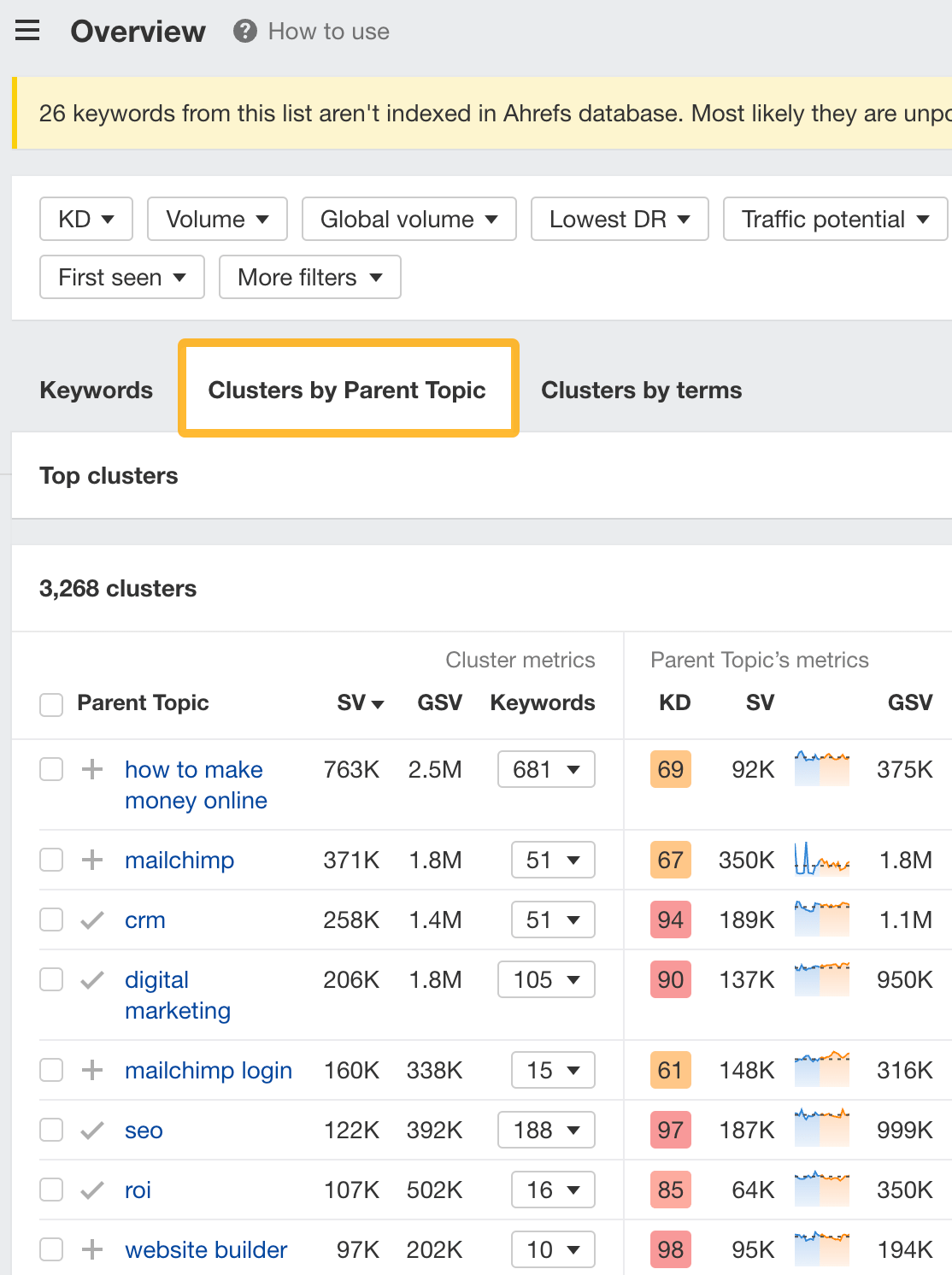

For example, MailChimp ranks for keywords like “what is digital marketing” and “digital marketing definition.” These and many others get clustered under the Parent Topic of “digital marketing” because people searching for them are all looking for the same thing: a definition of digital marketing. You only need to create one page to potentially rank for all these keywords.
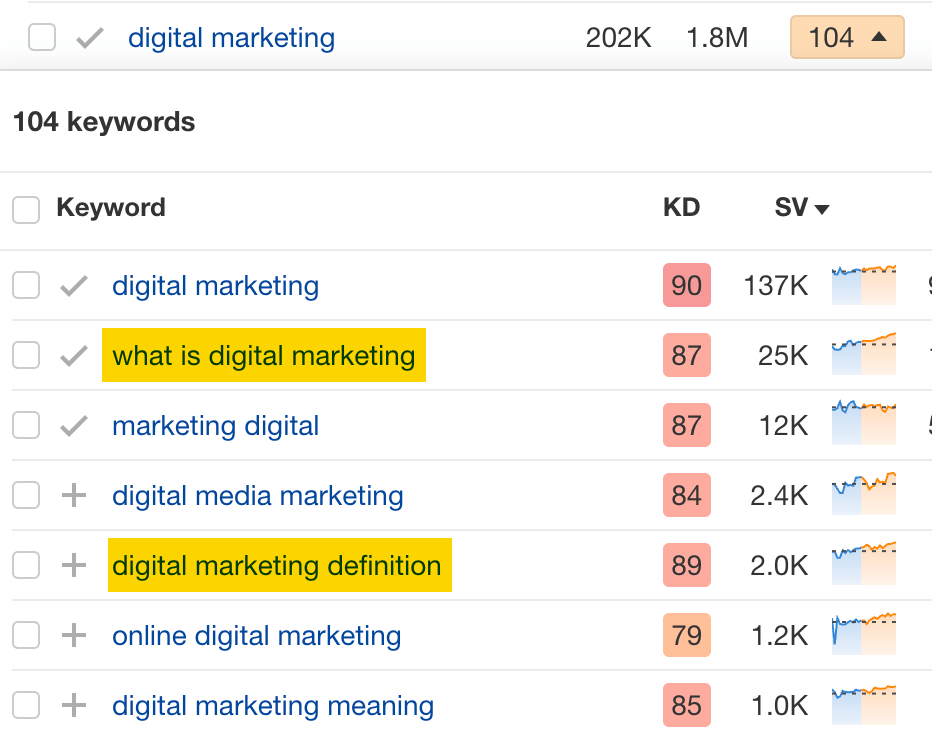

2. Optimize existing content by filling subtopics
You don’t always need to create new content to rank for competitors’ keywords. Sometimes, you can optimize the content you already have to rank for them.
How do you know which keywords you can do this for? Try this:
- Export your competitor’s keywords
- Paste them into Keywords Explorer
- Click the “Clusters by Parent Topic” tab
- Look for Parent Topics you already have content about
For example, if we analyze our competitor, we can see that seven keywords they rank for fall under the Parent Topic of “press release template.”


If we search our site, we see that we already have a page about this topic.


If we click the caret and check the keywords in the cluster, we see keywords like “press release example” and “press release format.”
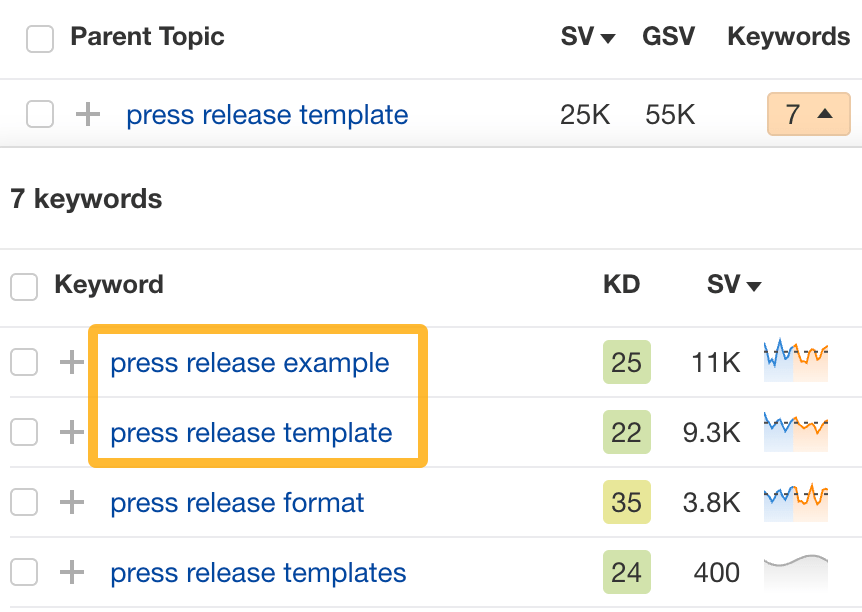

To rank for the keywords in the cluster, we can probably optimize the page we already have by adding sections about the subtopics of “press release examples” and “press release format.”
3. Target these keywords with Google Ads
Paid keywords are the simplest—look through the report and see if there are any relevant keywords you might want to target, too.
For example, Mailchimp is bidding for the keyword “how to create a newsletter.”


If you’re ConvertKit, you may also want to target this keyword since it’s relevant.
If you decide to target the same keyword via Google Ads, you can hover over the magnifying glass to see the ads your competitor is using.
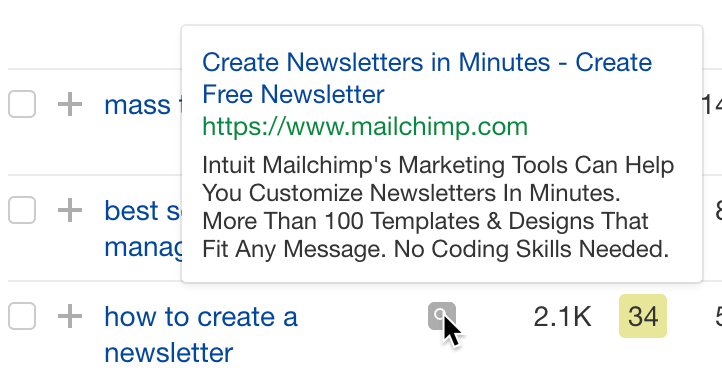

You can also see the landing page your competitor directs ad traffic to under the URL column.


Learn more
Check out more tutorials on how to do competitor keyword analysis:
SEO
Google Confirms Links Are Not That Important

Google’s Gary Illyes confirmed at a recent search marketing conference that Google needs very few links, adding to the growing body of evidence that publishers need to focus on other factors. Gary tweeted confirmation that he indeed say those words.
Background Of Links For Ranking
Links were discovered in the late 1990’s to be a good signal for search engines to use for validating how authoritative a website is and then Google discovered soon after that anchor text could be used to provide semantic signals about what a webpage was about.
One of the most important research papers was Authoritative Sources in a Hyperlinked Environment by Jon M. Kleinberg, published around 1998 (link to research paper at the end of the article). The main discovery of this research paper is that there is too many web pages and there was no objective way to filter search results for quality in order to rank web pages for a subjective idea of relevance.
The author of the research paper discovered that links could be used as an objective filter for authoritativeness.
Kleinberg wrote:
“To provide effective search methods under these conditions, one needs a way to filter, from among a huge collection of relevant pages, a small set of the most “authoritative” or ‘definitive’ ones.”
This is the most influential research paper on links because it kick-started more research on ways to use links beyond as an authority metric but as a subjective metric for relevance.
Objective is something factual. Subjective is something that’s closer to an opinion. The founders of Google discovered how to use the subjective opinions of the Internet as a relevance metric for what to rank in the search results.
What Larry Page and Sergey Brin discovered and shared in their research paper (The Anatomy of a Large-Scale Hypertextual Web Search Engine – link at end of this article) was that it was possible to harness the power of anchor text to determine the subjective opinion of relevance from actual humans. It was essentially crowdsourcing the opinions of millions of website expressed through the link structure between each webpage.
What Did Gary Illyes Say About Links In 2024?
At a recent search conference in Bulgaria, Google’s Gary Illyes made a comment about how Google doesn’t really need that many links and how Google has made links less important.
Patrick Stox tweeted about what he heard at the search conference:
” ‘We need very few links to rank pages… Over the years we’ve made links less important.’ @methode #serpconf2024″
Google’s Gary Illyes tweeted a confirmation of that statement:
“I shouldn’t have said that… I definitely shouldn’t have said that”
Why Links Matter Less
The initial state of anchor text when Google first used links for ranking purposes was absolutely non-spammy, which is why it was so useful. Hyperlinks were primarily used as a way to send traffic from one website to another website.
But by 2004 or 2005 Google was using statistical analysis to detect manipulated links, then around 2004 “powered-by” links in website footers stopped passing anchor text value, and by 2006 links close to the words “advertising” stopped passing link value, links from directories stopped passing ranking value and by 2012 Google deployed a massive link algorithm called Penguin that destroyed the rankings of likely millions of websites, many of which were using guest posting.
The link signal eventually became so bad that Google decided in 2019 to selectively use nofollow links for ranking purposes. Google’s Gary Illyes confirmed that the change to nofollow was made because of the link signal.
Google Explicitly Confirms That Links Matter Less
In 2023 Google’s Gary Illyes shared at a PubCon Austin that links were not even in the top 3 of ranking factors. Then in March 2024, coinciding with the March 2024 Core Algorithm Update, Google updated their spam policies documentation to downplay the importance of links for ranking purposes.
The documentation previously said:
“Google uses links as an important factor in determining the relevancy of web pages.”
The update to the documentation that mentioned links was updated to remove the word important.
Links are not just listed as just another factor:
“Google uses links as a factor in determining the relevancy of web pages.”
At the beginning of April Google’s John Mueller advised that there are more useful SEO activities to engage on than links.
Mueller explained:
“There are more important things for websites nowadays, and over-focusing on links will often result in you wasting your time doing things that don’t make your website better overall”
Finally, Gary Illyes explicitly said that Google needs very few links to rank webpages and confirmed it.
I shouldn’t have said that… I definitely shouldn’t have said that
— Gary 鯨理/경리 Illyes (so official, trust me) (@methode) April 19, 2024
Why Google Doesn’t Need Links
The reason why Google doesn’t need many links is likely because of the extent of AI and natural language undertanding that Google uses in their algorithms. Google must be highly confident in its algorithm to be able to explicitly say that they don’t need it.
Way back when Google implemented the nofollow into the algorithm there were many link builders who sold comment spam links who continued to lie that comment spam still worked. As someone who started link building at the very beginning of modern SEO (I was the moderator of the link building forum at the #1 SEO forum of that time), I can say with confidence that links have stopped playing much of a role in rankings beginning several years ago, which is why I stopped about five or six years ago.
Read the research papers
Authoritative Sources in a Hyperlinked Environment – Jon M. Kleinberg (PDF)
The Anatomy of a Large-Scale Hypertextual Web Search Engine
Featured Image by Shutterstock/RYO Alexandre
-

 PPC5 days ago
PPC5 days ago19 Best SEO Tools in 2024 (For Every Use Case)
-

 MARKETING6 days ago
MARKETING6 days agoStreamlining Processes for Increased Efficiency and Results
-
SEARCHENGINES6 days ago
Daily Search Forum Recap: April 17, 2024
-

 SEO6 days ago
SEO6 days agoAn In-Depth Guide And Best Practices For Mobile SEO
-

 PPC6 days ago
PPC6 days ago97 Marvelous May Content Ideas for Blog Posts, Videos, & More
-
SEARCHENGINES5 days ago
Daily Search Forum Recap: April 18, 2024
-

 MARKETING5 days ago
MARKETING5 days agoEcommerce evolution: Blurring the lines between B2B and B2C
-
SEARCHENGINES4 days ago
Daily Search Forum Recap: April 19, 2024








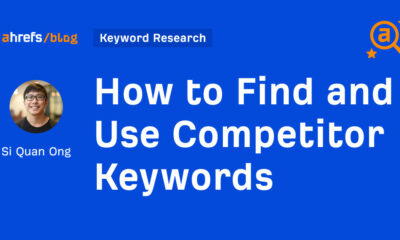







You must be logged in to post a comment Login